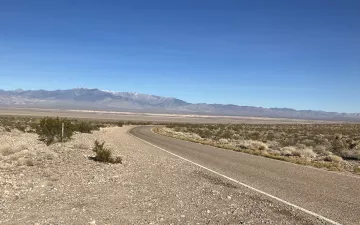As fast as the state is trying to preserve nature with the 30 by 30 campaign, it is also racing to cover large swaths of land with solar panels to reach its goal of 100% renewable energy by 2045. The desert in particular is especially being targeted for large-scale solar projects because it is flat and companies can lease public land cheaply. There are currently two projects underway to identify where large-scale solar could go. One is with the state of California and one is with the BLM.
The state’s California Energy Commission is developing a map of future large-scale solar or wind locations. The map will help the Public Utilities Commission plan where transmission lines and substations will be needed in the next 10-20 years. The state is working with environmental, conservation, and other groups to identify areas with high conservation, biodiversity, or climate refugia value that should not be made available for large-scale solar development. The map will be released in February, but the draft version identifies areas that cover most of Mono County and a lot of Inyo County that could host projects.
The BLM’s 2022 Solar PEIS project is revisiting the 2012 Solar PEIS project in order to expand it to five more states and increase the amount of acreage renewable energy companies could choose from. In 2012, all BLM lands in Mono County met the exclusion criteria, but some areas in Inyo County were identified as variances. Variance lands are areas that could be developed, but were not designated as solar energy zones (SEZs). Comments are due February 28.
Ways to Provide a Comment:
- Online: Click on the “Participate Now” button on the left. Enter your comment and information, then click “Submit”.
- Email: solar@blm.gov
- Mail: Solar Energy PEIS Scoping, 1849 C Street N.W., Washington, DC 20240
Effective comments address one or more of the following:
- Areas suitable for utility-scale solar energy development
- Areas that should be excluded from solar or wind energy development or criteria that the BLM should use to determine excluded areas
- Resources likely to be affected by solar energy development
- Potential resource issues that should be analyzed
- Data sources of which the agency may not be aware
- Reasonable alternatives to be considered in the analysis
Areas the state and the BLM have identified as available for renewable energy projects conflict with what Inyo County has identified. Inyo County’s Renewable Energy General Plan Amendment identifies sacrifice areas for small-scale solar projects in its desert region, the Owens Lake, and part of LAWs.
Charleston View in the far southeast corner of Inyo County is slated for 2,400 acres of solar panels. Five large-scale solar projects are planned on the Nevada side of the valley.

Is it NIMBYism or is it protecting the endangered desert tortoise and pristine lands in the Eastern Sierra? Yes, it is easier, faster, and cheaper to exploit the desert, but money shouldn’t be the only deciding factor. We need to put a price on nature and quality of life to even up the score. Wouldn't it be wiser in the long run to put solar panels up in already disturbed places, such as brown fields, parking lots, rooftops, or abandoned agricultural fields first?